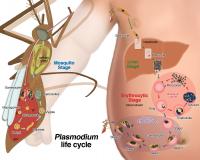
Life cycle of the human malaria parasite. Say "malaria" and most people think "mosquito," but the buzzing, biting insect is merely the messenger, delivering the Plasmodium parasites that sickened more than 200 million people globally in 2010 and killed about 660,000. Worse, the parasite is showing resistance to artemisinin, the most effective drug for treating infected people.
Now University of California, Riverside researchers who are trying to understand the biology of the parasite have discovered a potential weakness—low levels of DNA methylation in Plasmodium's genome "that may be critical to the survival of the parasite," said Karine Le Roch, an associate professor of cell biology, who led the research.
DNA methylation is a biochemical process involving the modification of DNA that plays an important role in development and disease.
A paper about the findings of Le Roch and her team, titled "Genome-wide Mapping of the DNA Methylation in the Human Malaria Parasite," appears in the December issue of the journal Cell Host & Microbe.
DNA methylation is a big deal in humans; it is so essential for normal development that abnormal DNA methylation patterns have been linked with many diseases, including cancers and neurological disorders, such as Alzheimer's disease. Until now, the existence of DNA methylation in the Plasmodium parasite was disputable, Le Roch said. There were published contradicting studies that used old technology to search for methylation, but Le Roch's team was able to confirm low levels of methylation using classical molecular approaches as well as new sequencing technology.
The DNA methylation enzyme found in Plasmodium is also quite different than the one in humans, Le Roch said, "and because it is different we can eventually find a way to target it and shut it down. If a drug can be developed that specifically inhibits the methylation enzyme, it could kill the parasite in infected humans."
Researchers are keen to find a new drug against malaria, since mutations in the parasite have made it resistant to the most effective drugs on the market. "We need a new drug every five years," Le Roch said, "because the parasites always find a way to develop resistance against a drug."
Le Roch's ultimate goal is to map the regulatory networks controlling the entire life cycle of the Plasmodium parasite. She reasons that researchers really need to understand the entire biology of the parasite and how it replicates. "We're trying to find its Achilles heel," she said. "If you look at only one level, it's not going to give you the answer. We need to put all the pieces of the puzzle together."
Plasmodium's life cycle is very complex as it lives in both humans and mosquitoes. The parasite moves to the salivary glands of an infected mosquito. Once the mosquito bites a human, the parasite is injected into the blood stream and quickly reaches the liver cells, where it rapidly reproduces asexually, creating thousands of new parasites that move into red blood cells, their favorite food source. The parasite is transmitted from humans to mosquitoes when a mosquito draws blood from an infected human.
Source : iqbal@ucr.edu
 Print Article
Print Article Mail to a Friend
Mail to a Friend
